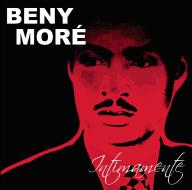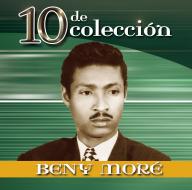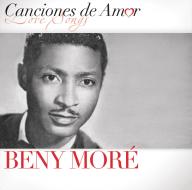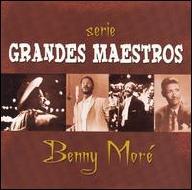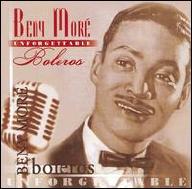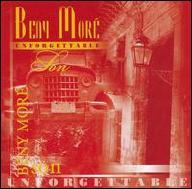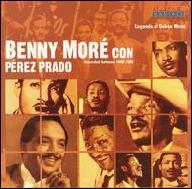Moré's genius lay in his synthesis of two of the major currents of Cuban song -- Afro-Cuban son and the Spanish-derived guajiro music of the Cuban countryside. He owed at least some of his singing style to a series of soneros who preceded him: Antonio Machin, Miguelito Valdes, and Orlando Cascarita Guerra. Moré's intimacy with both the African and European elements in Cuban music allowed him to be comfortable in all different styles. He was equally successful with boleros as with mambos and rhumbas. Most important is what he conveyed with his singing: a tenderness and direct emotional appeal in his boleros, a hip-shaking exuberance in his mambos. Though he could not read music, Moré composed two of his smash hits, Bonito y Sabroso and Que Bueno Baila Usted. He also doubled as a bandleader and assembled a powerful big band comprised of talented musicians like trumpeters Alejandro El Negro Vivar and Alfredo Chocolate Armenteros, and trombonist and arranger Generoso El Tojo Jimenez. His was the quintessential Afro-Cuban big-band sound of the 1950s: brash, multi-textured, dynamic. But unlike New York bands like Machito His Afro-Cubans, Moré was not pushing the boundaries of Latin jazz. His music was more "pop" than Machito's, but it was anything but formulaic.
Born Bartolome Maximiliano Moré in 1919 in the village of Santa Isabel de Las Lajas in Las Villas Province, Cuba, Moré left for Havana as a teenager and for several years worked a variety of odd jobs while performing as a street singer in the city's port area. His big break came in 1945, when he accompanied the Miguel Matamoros conjunto to Mexico. In the late '40s, Mexico City was a magnet for Cuban entertainers seeking to make it big in the Mexican film industry. After touring Mexico, Matamoros returned to Cuba, but Moré decided to stay behind. Before leaving, Matamoros counseled Moré to change his name since "bartolo" meant donkey in Mexican slang. Rechristened Beny Moré, in a year or two he was discovered by Mario Rivera Conde, the director of RCA Victor Mexico, who paired him with a series of high-caliber orchestras, including those of Perez Prado and Mexican composer Raphael De Paz.
Moré's early recordings in Mexico include a balance of uptempo tunes and ballads; this proportion changed in favor of ballads when he finally fronted his own band. What's striking about the early sessions is the consistent quality and tastefulness of the orchestral accompaniment. Moré sings with five different orchestras on these sessions, yet there are few jarring contrasts. The Perez Prado orchestra is an exception to this rule; Prado's flailing piano style and trademark grunts jar in a marvelous, amphetamine-driven way. Rivera Conde's pairing of Prado and Moré was a masterstroke and produced some of the most high-energy recordings of Moré's career. Moré sang some of his most memorable songs while on his Mexican sojourn -- Bonito y Sabroso, San Fernando, Donde Estabas Tu -- with the Raphael De Paz Orchestra. But perhaps Moré's best-known song, the bolero Como Fue, was recorded with neither Prado nor De Paz, but with the orchestra of Ernesto Duarte. Como Fue was included in the soundtrack of the film #Mambo Kings Play Songs of Love, where it added authenticity to an otherwise watery collection of Latin music.
Moré returned to Cuba in 1953 and assembled his own big band, with whom he crisscrossed Cuba until his death. Moré was intensely loyal to his musicians, referring to them as his tribu (tribe). Because he always insisted on having a large band, he was known to have gone out of pocket on his RCA recordings to pay his men. They responded by embellishing his songs with subtle, ornate orchestral playing. While Moré continued to record uptempo smash hits such as Francisco Guayabal and Que Bueno Baila Usted, he focused on boleros, a natural showcase for his vocal and interpretive gifts. Moré had a signature vocal technique, a sort of glissando, that he used everywhere in varying forms. Typically, he would hold a note, then slide up the scale to a higher note and hold it there for a few seconds. It's an impressive, exciting device, and he uses it to build drama on boleros like Tu Me Sabes Comprender and No Puedo Callar. A less frequently used but equally distinctive technique was Moré's seagull squawk, which he includes at the finale of the uptempo Soy Campesino.
It is unfortunate that Moré never brought his outstanding band to record or perform in the United States, even though he was active during one of the rare moments in U.S. pop music history when authentic Cuban music was in demand. Moré decided to stay in Cuba after the Revolution, but he didn't live long, a victim of his love for rum. All rumors to the contrary notwithstanding, Beny Moré finally succumbed to cirrhosis of the liver on February 19, 1963, in Havana. Moré's recorded output was relatively small, cut short as it was by his premature death. In 1992, BMG Music released the majority of Moré's 1948-1958 recordings for RCA Victor on five CDs for its Tropical Series. Moré never recorded for anyone other than RCA, so all his hits are here. Nevertheless, his earliest recordings with the Miguel Matamoros conjunto are missing, and only some of his songs with the Perez Prado orchestra are included. From a technical standpoint, the discs are terrific (they sound as if they were made yesterday), but three of the five albums have no liner notes to speak of and information about session dates and personnel is either very sketchy or nonexistent, which is shabby treatment indeed for an artist of Beny Moré's stature. Moré's great legacy, though, is clear on the recordings themselves: a voice that can evoke memories of lost romance, or make you dance with joyous abandon. ~ Spencer Harrington, Rovi



